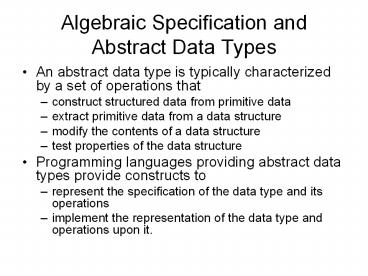Algebraic Specification and Abstract Data Types - PowerPoint PPT Presentation
Title:
Algebraic Specification and Abstract Data Types
Description:
Intension, Extension, and Final Algebras. Two objects are said to be equivalent in intension if their representation is the same. ... – PowerPoint PPT presentation
Number of Views:195
Avg rating:3.0/5.0
Title: Algebraic Specification and Abstract Data Types
1
Algebraic Specification and Abstract Data Types
- An abstract data type is typically characterized
by a set of operations that - construct structured data from primitive data
- extract primitive data from a data structure
- modify the contents of a data structure
- test properties of the data structure
- Programming languages providing abstract data
types provide constructs to - represent the specification of the data type and
its operations - implement the representation of the data type and
operations upon it.
2
Algebraic Specification
- An algebra is specified by giving a sort (this is
the name of a set), and a set of signatures (this
is a set of function specifications). - For example, think of a simple algebra for
arithmetic with addition and subtractionltS,S
? S ? S, -S ? S ? Sgt - The specification of an algebra is an abstract
entity. We can create a associate a particular
algebra with the specification by associating a
set (called the carrier set) with the sort and a
specific function with each operator symbols in
the signatures. - Properties of any particular algebra (or model of
an algebra) are specified by giving axioms such
as-((x,y),y)x
3
Algebraic Specification of the Data Type of
Complex Numbers
- type complex imports realoperations complex
? complex ? complex - complex ? complex ?
complex complex ? complex ? complex /
complex ? complex ? complex - complex ?
complex makecomplex real ? real ?
complex realpart complex ? real imaginarypart
complex ? realvariables x,y,z complex r,s
realaxioms realpart(makecomplex(r,s))
r imaginarypart(makecomplex(r,s))
s realpart(xy) realpart(x) realpart(y) ... - There are actually some problems with this
specification. For example, how can it handle
division by 0 (which yields an error)?
4
Consider the specification of a queue data type
- type queue(element) imports booleanoperations
createq queue enqueue queue ? element ?
queue dequeue queue ? queue frontq queue ?
element emptyq queue ? booleanvariables q
queue, x elementaxioms emptyq(createq)
true emptyq(enqueue(q,x)) false frontq(createq
) error frontq(enqueue(q,x)) if emptyq(q)
then x else frontq(q) dequeue(createq)
error dequeue(enqueue(q,x)) if emptyq(q) then
q else enqueue(dequeue(q),x) - Note the use of a data type parameter, element
- If you look at the signature of frontq, you see
that its supposed to return a boolen, but axiom
3 requires that it be able to return something
called error. This axiom does not follow the
rules. - Note a similar problem for dequeue. Louden
introduces the idea of a constructor (that
creates a new object of the data type being
defined) and an inspector (that retrieves
previously constructed values). - But note that dequeue is defined constructively,
in terms of the queue value that it returns which
is created by calling enqueue. Evaluate
dequeue(enqueue(enqueue(enqueue(createq,1),2),3),4
) to see why I consider dequeue to be a
constructor! - In Loudens nomenclature, frontq is a selector,
and emptyq is a predicate.
5
Formal Mathematical Treatment of Abstract Data
Types
- The nomenclature used in formal discussions of
ADTs is borrowed from Algebra and Logic. - An ADT specification describes an existential (or
potential) type because it asserts the existence
of an actual type without really demonstrating
that such an actual type really exists. - Any actual type that satisfies the axioms of an
ADT is said to be a model of the ADT. - Given a carrier set, we can construct the free
algebra of terms for the algebra. This is the
set of all valid combinations of the
operationscreateqdequeue(createq)enqueue(creat
eq,1)dequeue(enqueue(createq,1))enqueue(enqueue(
createq, 1),2)...
6
Quotient Algebra
- We can furthermore construct the quotient algebra
of the equivalence relation generated by the
equational axioms by - identifying a normal order for the terms in the
free algebra - removing any term tn that is equivalent (under
the axioms) to a lower order term tm. - If our algebra is F and our equivalence
relationis , the quotient algebra is denoted
F/. - The quotient algebra of a specification is known
as its initial algebra. - Elements in the initial algebra are assumed to be
unique unless it can somehow be proven that they
are equivalent.
7
Consistency, Soundness, and Completeness
- A theory or proof system is said to be consistent
if it does not contain both the terms A and A.
Given our queue specification, we cant, for
example, have both of empty(createq)trueand em
pty(createq)falsein the initial algebra. - A theory is said to be sound if any statement
that can be proven is true (that is, if any
outcome of application of the axioms is in the
model). Because of the way we construct an
initial algebra from the carrier set and the
signatures, it will necessarily be sound. - A theory is said to be complete if any true
statement can be proven from the axioms. When
Louden says this means the initial algebra is not
too small, hes saying that the initial algebra
hasnt left out any true statements. Any model
of the algebra will be an actual data type. If
something is true of every model of the algebra,
yet, it cannot be proven from the axioms, then
the set of axioms is incomplete.
8
Intension, Extension, and Final Algebras
- Two objects are said to be equivalent in
intension if their representation is the same. - Two objects are said to be equivalent in
extension if they cannot be distinguished by any
operations that can be applied to them. - Louden shows an array ADT example in which items
that are intensionally different insertIA(insert
IA(createIA,1,1),2,2) -- A insertIA(insertIA(crea
teIA,2,2),1,1) -- Bare extensionally
equivalent A B iff for all i, extractIA(A,i)
extractIA(B,i)































